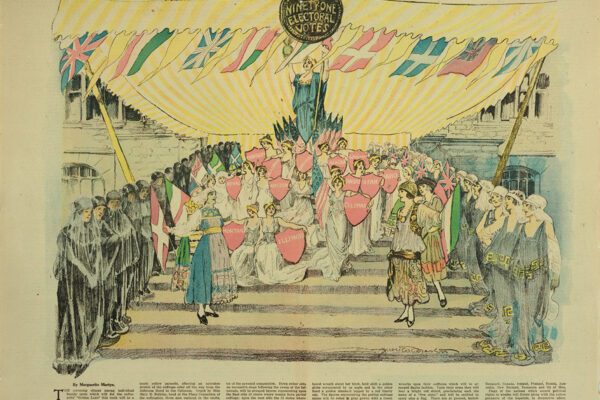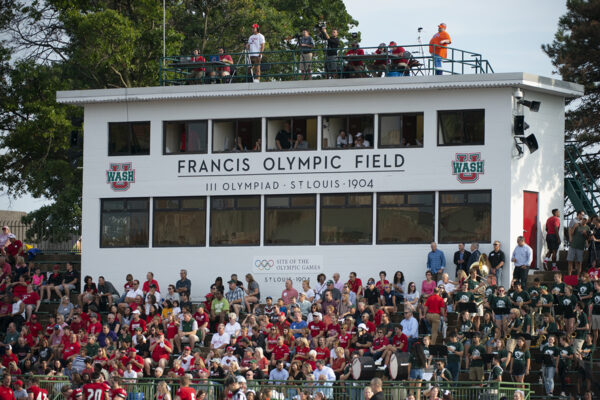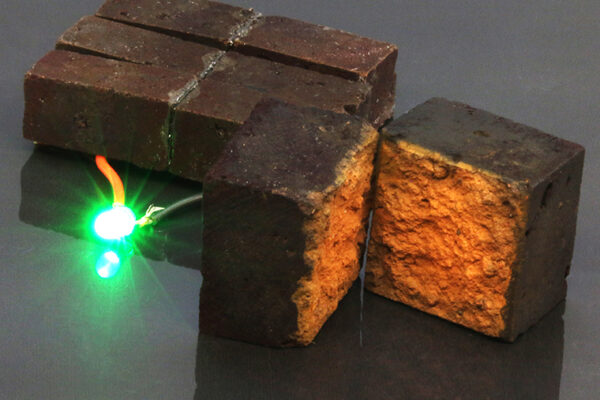April 30, 2004, marks the 100th anniversary of the start of the 1904 World’s Fair, an event that showcased science advancements that startled the imagination a century ago and foretold technology still in place today. It ushered in a new era in which machines began taking over the work of humans, still a hot topic one hundred years later. The fair was headquartered on the campus of Washington University in St. Louis, where significant scientific developments continue today, most notably at the nation’s second-ranked medical school but also across many science and engineering disciplines.

The fair, also known as the Louisiana Purchase Exposition (because it marked the 100th anniversary of Thomas Jefferson’s great acquisition), unveiled to the world new ideas, products and scientific advances that enthralled thousands of visitors. There was a meeting of great scientific minds at the fair, and Thomas Edison was even on hand to oversee use of electricity.
Washington University played a large role in the fair that predicted the development and mass use of electricity and the x-ray, not to mention the infant incubator, the private automobile and a number of other everyday staples of the 20th and 21st centuries.
Among the scientific wizardry introduced at the 1904 World’s Fair were:
• The X-ray machine, now standard equipment in both hospitals and airports.
• The baby incubator. Tennessean E.M. Bayliss brought actual infant incubators, invented in 1888 by Drs. Alan M. Thomas and William Champion, to an exhibit on the Fair’s Pike. Throughout the fair, premature infants from local orphanages and poor families lived in a row of 14 metal-framed glass incubators. Fairgoers paid to watch nurses care for the babies, and the admission charge helped fund the project.
• The electric typewriter, viewed by many secretaries past and present as the greatest invention of all time.
• The telautograph, an early version of the fax machine, invented by Elisha Gray of Chicago. This invention had received little notice at the 1893 World’s Columbian Exposition in Chicago. Even after 1904, it took decades before this handy device earned its place as an indispensable office machine.
• The telephone answering machine, then called the Poulson telegraphone.
• Household and hotel products such as the tabletop stove, coffeemaker, automatic potato masher, bread machine and dishwasher. The electric dumbwaiter was a welcome update of the old hand-operated house elevator used by housewives and kitchen maids.
• The automatic gatekeeper at each fair entrance was the first to admit one person after receiving the proper coin, and then automatically lock again until the next coin was inserted.
• Electricity was the star of the show. All the major buildings on the fairgrounds were lit inside and out by electric lights, and the fair’s thoroughfares were illuminated by electric lights. Within the Palaces of Machinery, Transportation and Electricity, many electric-powered machines and appliances were on display. Inventor Thomas Edison himself was brought in to oversee the assembly of the electrical exhibits.
• The electrical plug and wall outlet. One hundred years later, no house can have too many outlets.
• Wireless telegraphy came into its own in an exhibit of the DeForest Wireless Telegraphy Company, which sent daily news of the fair to the St. Louis Post-Dispatch and the St. Louis Star via its observation tower and seven stations on the fairgrounds. Also featured in the DeForest exhibit was a wireless telephone, precursor of the now-ubiquitous cellular telephone.
• A new underwater battleship called the submarine made a big splash, although the U.S. Navy’s exhibit didn’t include an actual submarine.
• Still in its infancy, the automobile was being adapted for private use, with its 40-horsepower engine capable of moving at 40 miles per hour. One shortsighted critic scoffed in a Cosmopolitan article that the exhibit of 140 fancy private automobiles was fanciful because the best use of automobiles would be for public transportation and freight — the private car would never catch on.
Letter carriers tooled around the fairgrounds in automobiles to collect mail, the first use of the automobile for that purpose in the United States.
A related invention by Thomas Edison, the steel-nickel storage battery for the automobile, was introduced at Edison’s own exhibit.
• The gas producer and the resultant gas engine, already being used in Europe. A gas producer could transform a pound of coal into three times the power of a steam boiler. As expected, this revolution in industry had a profound effect on coal mining, transportation and air quality.
• The airplane. The fair featured several demonstrations of various flying machines that took off and landed from the aeronautic field, located in the area that later became Washington University’s Fraternity Row. Although a contest offered $100,000 to anyone who could build anything that could fly bearing at least one person, few were successful.
And there was the meeting of great minds at the fair. “One of the most important events of the fair was the International Congress of Arts and Sciences, which brought together prominent scholars from all over the world in every academic discipline, including some who were on the Washington University faculty,” said Washington University Archivist Carole Prietto. Most of the sessions were held at the university’s Ridgley Hall. “After the fair, the proceedings of the Congress were published, and three of the eight volumes of that record deals with science and technology.”
The original eight volumes of the proceedings are available at the Olin Library at Washington University. Photos of the Congress and other fair activities are available as well.
Other less scientific, but perhaps equally notable objects introduced at the fair were: the ice cream cone, iced tea and the hot dog. While these items are believed to have existed before the fair, many visitors had never seen them prior to their trip to St. Louis in the summer of 1904.
Overall, the advances showcased at the 1904 World’s Fair ushered in a new era in which machines began taking over the work of humans, a phenomenon still a topic for debate and thought 100 years later.
To request a copy of the above photo in high resolution, please contact Judy Jasper Leicht at (314) 935-5408.


